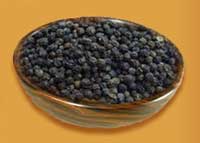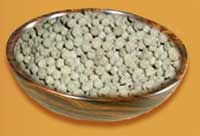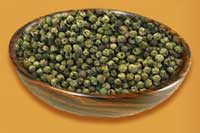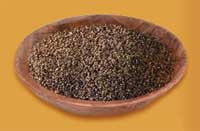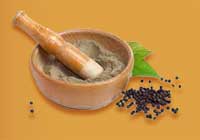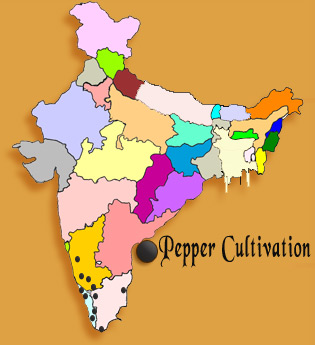PEPPER
Introduction
Pepper is the dehydrated fully grown berry of Piper niygrum, a mountaineering, perpetual shrub mostly found in places which are hot, moist like Southern India. Under the process of growth pepper vines are stalked over support as columns, which can grow up to 5-6 mtrs tall and 1-2 mtr in diameter. The mountaineering woody stems have inflated nods with clinging roots at every node, which helps in strengthening the vine to the maintain standards. It has instantly upward growing main stem and have sideway shoots from the axils of the leaves having smaller inter nodes without any adventitious roots. In such twigs the terminal buds get customized into an inflorescence or spike and the auxiliary buds continue the remaining further growth. The root system is limited to 75-100 cm of radius and strength.
The inflorescence is a pendent spike which can grow up to 3-15 cm in length and can bear up to 50-150 flowers in a single shoot. Flowers are tiny, white or pale yellow colored, arranged spirally on plump pedantries. The type is unsurprisingly a self-pollinated and pollen scattering is aided by the occurrence of water droplets. Fruit is a sole seeded drupe frequently called as a berry. It is round in shape, green in color which changes to red in color on ripping.
Common Names
Piper nigrum is the scientific botanical name of the plant. In the common languages of Indian IE in Hindi it is called as Kali mirch; in Bengali it is called as Kala morich, golmorich; in Gujarati it is called as Kalamari, kalomirich; in Kannada it is called as Kare menasu; in Kashmiri it is called as Marutis; in Malayalam it is called as Kurumulaku, nallamulaku; in Marathi it is called as Mira, kali mirch; in Oriya it is called as Gol maricha; in Punjabi it is called as Kali mirch; in Sanskrit it is called as Marich ushna, hapusha; in Tamil it is called as Milagu; in Telugu it is called as Miriyala tige; in Urdu it is called as Kali mirch, Siah mirch.
History
Pepper is a strong spice and a refreshment and has been highly treasured for centuries. Europeans' demand for the pepper played a very large part in finding sea routes to the spice being cultivated in the East during the 15th century. When pepper was brought to the Roman ports it was bought from ounce for ounce with expensive metals. In the Middle Ages pepper was also established as a currency as it was perfect for trade because it does not worsen over time and to make it available it was kept dehydrated and out of sunlight so it was promising to pay rent, taxes and offering with this spice.
The term peppercorn payment used to actually mean something. Once the British authority in India started the East India Company it took control over the pepper trade and the enormous tonnage brought in on its ships condensed the price, whirling it into an each day item rather than a treat. Pepper is neither a savoury nor a sweet and adds flavor and spiciness to cooking.
Varieties
Black
Black pepper is manufactured from the still-green immature pepper plant. The fruits are cooked for a short time in hot water, both to dirt free them and to organize them for drying. They are dehydrated in the sun or by machine for quite a lot of days, during which the pepper in the region of the seed shrinks and darkens into a skinny, crumpled black layer. Once dried out, the spice is called as black peppercorn.
There are different types of black pepper:
Tellicherry Black
Tellicherry Black pepper is mostly grown in South India. The sparkling wine of black pepper. Very brave, pungent smell. Not for the faint hearted. It is to be used where we want a very marked, lingering pepper flavor. Best seen in Indian cuisine.
Sarawak Black
Sarawak Black pepper is from Borneo and Malaysia which is relatively gentle with a fruity bouquet. Best suited to provide delicate flavors.
Lampong Black
Lampong Black pepper is from Sumatra, Indonesia which is Mildly pungent and sweet-smelling. This is the type of pepper which has to be used while making curry mixtures.
White
White pepper is made out of the core of a matured fruit after the shell has been detached. This is habitually accomplished by a procedure known as retting, where fully riped peppers are drenched in water for about a week, during which the fleshy tissue of the pepper softens and decomposes. Rubbing the pepper then removes what is left in the fruit, and the naked seed is dehydrated. White pepper is occasionally used in dishes like light coloured sauces or smashed potatoes, where grinded black pepper would obviously stand out.
There is discrepancy regarding that it is normally spicier. They have conflicting flavor due to the presence of definite compounds in the external fruit layer of the berry that are not there in the seed.
Green
Green pepper is meeker than black pepper but like black it is made from the immature fruits. Dehydrated green peppercorns are made in a way that preserves the green colour. Fresh and perishable green pepper fruits, largely unfamiliar in the West are used in some of the great Asian cuisines, particularly in Thai cuisine. Their flavor has been described as spicy and fresh, with a very bright fragrance. They decay quickly if not dehydrated or preserved. To preserve, immature fruits are pickled in salt water or vinegar before dehydrating.
Uses
Cooking
Pepper is largely used by meat packers and in baking, canning, pickling, considering it because of its preservative worth. It has the capability to correct the flavor of dishes, therefore used as a last dash at the end of cooking to efficiently adjust the flavor. It is a significant component of culinary seasoning for worldwide use and is a necessary element in numerous commercial foodstuff. It has also been used as a component in spice mixes. White pepper is used in merchandise like mayonnaise where black scraps of black pepper are not liked. Other produces in use are pepper oil, green pepper in brine, oleoresin, micro encapsulated pepper, dehydrated green pepper, frozen pepper, etc.
Medicine
The medicinal benefits of hot pepper have been well known for a lot of centuries by mankind. Pepper has a very wide range of use such as a substitute for medicine. Although some chillies are fairly hot, most are treasured for their comforting effects on the digestive system, aid from the symptoms of colds, painful throats and fevers, flow, particularly for cold hands and feet, and as a hangover remedy. Peppers can be active as a heart refreshment which regulates blood current and toughens the arteries, possibly sinking heart attacks. Nutritionally, fresh chilli peppers are an outstanding source of calcium and vitamin C.
Pepper Cultivation in India

